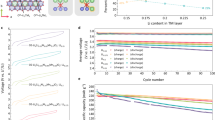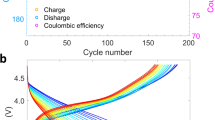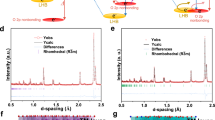Abstract
Layered lithium-rich transition metal oxides are promising cathode candidates for high-energy-density lithium batteries due to the redox contributions from transition metal cations and oxygen anions. However, their practical application is hindered by gradual capacity fading and voltage decay. Although oxygen loss and phase transformation are recognized as primary factors, the structural deterioration, chemical rearrangement, kinetic and thermodynamic effects remain unclear. Here we integrate analysis of morphological, structural and oxidation state evolution from individual atoms to secondary particles. By performing nanoscale to microscale characterizations, distinct structural change pathways associated with intraparticle heterogeneous reactions are identified. The high level of oxygen defects formed throughout the particle by slow electrochemical activation triggers progressive phase transformation and the formation of nanovoids. Ultrafast lithium (de)intercalation leads to oxygen-distortion-dominated lattice displacement, transition metal ion dissolution and lithium site variation. These inhomogeneous and irreversible structural changes are responsible for the low initial Coulombic efficiency, and ongoing particle cracking and expansion in the subsequent cycles.
This is a preview of subscription content, access via your institution
Access options
Access Nature and 54 other Nature Portfolio journals
Get Nature+, our best-value online-access subscription
$32.99 / 30 days
cancel any time
Subscribe to this journal
Receive 12 print issues and online access
$259.00 per year
only $21.58 per issue
Buy this article
- Purchase on SpringerLink
- Instant access to full article PDF
Prices may be subject to local taxes which are calculated during checkout





Similar content being viewed by others
References
Wang, J. et al. Lithium- and manganese-rich oxide cathode materials for high-energy lithium ion batteries. Adv. Energy Mater. 6, 1600906 (2016).
Nayak, P. K. et al. Review on challenges and recent advances in the electrochemical performance of high capacity Li- and Mn-rich cathode materials for Li-ion batteries. Adv. Energy Mater. 8, 1702397 (2018).
Hy, S., Liu, H., Zhang, M., Qian, D. & Hwang, B. Performance and design considerations for lithium excess layered oxide positive electrode materials for lithium ion batteries. Energy Environ. Sci. 9, 1931–1954 (2016).
Zuo, W. et al. Li-rich cathodes for rechargeable Li-based batteries: reaction mechanisms and advanced characterization techniques. Energy Environ. Sci. 13, 4450–4497 (2020).
Assat, G. et al. Fundamental interplay between anionic/cationic redox governing the kinetics and thermodynamics of lithium-rich cathodes. Nat. Commun. 8, 2219 (2017).
Liu, T. et al. Origin of structural degradation in Li-rich layered oxide cathode. Nature 606, 305–312 (2022).
Huang, J. et al. Non-topotactic reactions enable high rate capability in Li-rich cathode materials. Nat. Energy 6, 706–714 (2021).
Hong, J. et al. Metal–oxygen decoordination stabilizes anion redox in Li-rich oxides. Nat. Mater. 18, 256–265 (2019).
He, X. et al. Chemical and structural evolutions of Li–Mn-rich layered electrodes at different current densities. Energy Environ. Sci. 15, 4137–4147 (2022).
Lin, F. et al. Metal segregation in hierarchically structured cathode materials for high-energy lithium batteries. Nat. Energy 1, 15004 (2016).
Xu, Y. et al. In situ visualization of state-of-charge heterogeneity within a LiCoO2 particle that evolves upon cycling at different rates. ACS Energy Lett. 2, 1240–1245 (2017).
Sorrentino, A. et al. Soft X-ray transmission microscopy on lithium-rich layered-oxide cathode materials. Appl. Sci. 11, 2791 (2021).
Wang, L. et al. Reaction inhomogeneity coupling with metal rearrangement triggers electrochemical degradation in lithium-rich layered cathode. Nat. Commun. 12, 5370 (2021).
Shapiro, D. A. et al. Chemical composition mapping with nanometre resolution by soft X-ray microscopy. Nat. Photonics 8, 765–769 (2014).
Yu, Y. S. et al. Three-dimensional localization of nanoscale battery reactions using soft X-ray tomography. Nat. Commun. 9, 921 (2018).
Yang, Y. et al. Quantification of heterogeneous degradation in Li-ion batteries. Adv. Energy Mater. 9, 1900674 (2019).
Zheng, J. et al. Structural and chemical evolution of Li- and Mn-rich layered cathode material. Chem. Mater. 27, 1381–1390 (2015).
Yan, P. et al. Injection of oxygen vacancies in the bulk lattice of layered cathodes. Nat. Nanotechnol. 14, 602–608 (2019).
House, R. A. et al. First-cycle voltage hysteresis in Li-rich 3d cathodes associated with molecular O2 trapped in the bulk. Nat. Energy 5, 777–785 (2020).
House, R. A. et al. The role of O2 in O-redox cathodes for Li-ion batteries. Nat. Energy 6, 781–789 (2021).
Zhou, Y. N. et al. High-rate charging induced intermediate phases and structural changes of layer-structured cathode for lithium-ion batteries. Adv. Energy Mater. 6, 1600597 (2016).
Sharifi-Asl, S. et al. Revealing grain-boundary-induced degradation mechanisms in Li-rich cathode materials. Nano Lett. 20, 1208–1217 (2020).
Xu, B., Fell, C. R., Chi, M. & Meng, Y. S. Identifying surface structural changes in layered Li-excess nickel manganese oxides in high voltage lithium ion batteries: a joint experimental and theoretical study. Energy Environ. Sci. 4, 2223–2233 (2011).
Zhong, J. et al. Mitigating evolution of lattice oxygen and stabilizing structure of lithium-rich oxides by fabricating surface oxygen defects. Electrochim. Acta 328, 134987 (2019).
Csernica, P. M. et al. Persistent and partially mobile oxygen vacancies in Li-rich layered oxides. Nat. Energy 6, 642–652 (2021).
Mohanty, D. et al. Unraveling the voltage-fade mechanism in high-energy-density lithium-ion batteries: origin of the tetrahedral cations for spinel conversion. Chem. Mater. 26, 6272–6280 (2014).
Liu, X. et al. Origin and regulation of oxygen redox instability in high-voltage battery cathodes. Nat. Energy 7, 808–817 (2022).
Qiu, B. et al. Gas–solid interfacial modification of oxygen activity in layered oxide cathodes for lithium-ion batteries. Nat. Commun. 7, 12108 (2016).
Kawai, K. et al. Kinetic square scheme in oxygen-redox battery electrodes. Energy Environ. Sci. 15, 2591–2600 (2022).
Guttmann, P. et al. Nanoscale spectroscopy with polarized X-rays by NEXAFS-TXM. Nat. Photonics 6, 25–29 (2012).
Yu, X. et al. Understanding the rate capability of high-energy-density Li-rich layered Li1.2Ni0.15Co0.1Mn0.55O2 cathode materials. Adv. Energy Mater. 4, 1300950 (2014).
Li, Q. et al. Improving the oxygen redox reversibility of Li-rich battery cathode materials via Coulombic repulsive interactions strategy. Nat. Commun. 13, 1123 (2022).
Li, N. et al. Unraveling the cationic and anionic redox reactions in a conventional layered oxide cathode. ACS Energy Lett. 4, 2836–2842 (2019).
Sun, T. et al. Soft X‑ray ptychography chemical imaging of degradation in a composite surface-reconstructed Li-rich cathode. ACS Nano 15, 1475–1485 (2021).
He, W. et al. Challenges and recent advances in high capacity Li-rich cathode materials for high energy density lithium-ion batteries. Adv. Mater. 33, 2005937 (2021).
Yoon, W. S. et al. Investigation of the charge compensation mechanism on the electrochemically Li-ion deintercalated Li1−xCo1/3Ni1/3Mn1/3O2 electrode system by combination of soft and hard X-ray absorption spectroscopy. J. Am. Chem. Soc. 127, 17479–17487 (2005).
Bessette, S. et al. Nanoscale lithium quantification in LixNiyCowMnzO2 as cathode for rechargeable batteries. Sci. Rep. 8, 17575 (2018).
Ruess, R. et al. Influence of NCM particle cracking on kinetics of lithium-ion batteries with liquid or solid electrolyte. J. Electrochem. Soc. 167, 100532 (2020).
Zhang, W. et al. Kinetic pathways of ionic transport in fast-charging lithium titanate. Science 367, 1030–1034 (2020).
Hu, E. et al. Evolution of redox couples in Li- and Mn-rich cathode materials and mitigation of voltage fade by reducing oxygen release. Nat. Energy 3, 690–698 (2018).
Kikkawa, J. et al. Chemical states of overcharged LiCoO2 particle surfaces and interiors observed using electron energy-loss spectroscopy. J. Phys. Chem. C 119, 15823–15830 (2015).
He, X. et al. The passivity of lithium electrodes in liquid electrolytes for secondary batteries. Nat. Rev. Mater. 6, 1036–1052 (2021).
Dai, K. et al. High reversibility of lattice oxygen redox quantified by direct bulk probes of both anionic and cationic redox reactions high reversibility of lattice oxygen redox quantified by direct bulk probes of both anionic and cationic redox reactions. Joule 3, 518–541 (2019).
Liu, H. et al. Operando lithium dynamics in the Li-rich layered oxide cathode material via neutron diffraction. Adv. Energy Mater. 6, 1502143 (2016).
Acknowledgements
We acknowledge the European Synchrotron Radiation Facility (ESRF) for provision of synchrotron radiation facilities under proposal number ma4084, and thank the Helmholtz-Zentrum Berlin fur Materialien und Energie for the allocation of synchrotron radiation beamtime, and support from TESCAN (Shanghai, China) for SEM-FIB and TOF-SIMS measurements. We are grateful for support from the Shenzhen Science and Technology Program (grant number RCYX20231211090432060 to Y.L.), the Sichuan Science and Technology Program (grant number 2023NSFSC1131 to Z.L.), the Shenzhen Stable Support Plan Program for Higher Education Institutions Research Program (grant number 20231120094333001 to Y. Zeng), and the Major Research Plan of the National Natural Science Foundation of China (grant number 92372207 to J. Lu and Y.X.).
Author information
Authors and Affiliations
Contributions
X. He conceived and planned the project concept. J. Lu, J. Li, Y.L. and X. He supervised the project. Z.L. performed experiments and initial data analysis. Y. Zeng developed the deep analysis of the tomography data and reconstructed the 3D structure. J.T. and B.L. carried out STEM measurements and internal strain analyses. Y. Zhu and H.W. undertook the FIB preparation. H.W. performed TOF-SIMS analyses and stress simulations. X. Hou and X.G. performed NPD refinement. P.G. carried out soft TXM measurement. Y.Y. and P.C. carried out X-ray phase-contrast nanotomography and established the 3D reconstruction. D.Z. performed the rapid XRD measurements. Y.X., Y.W., M.W. and R.K. contributed to the scientific discussion of the data and revised the paper. All authors contributed to the interpretation, conclusions and preparation of the paper.
Corresponding authors
Ethics declarations
Competing interests
The authors declare no competing interests.
Peer review
Peer review information
Nature Nanotechnology thanks Ke-Jin Zhou and the other, anonymous, reviewer(s) for their contribution to the peer review of this work.
Additional information
Publisher’s note Springer Nature remains neutral with regard to jurisdictional claims in published maps and institutional affiliations.
Supplementary information
Supplementary Information
Supplementary Figs. 1–29, Tables 1–4 and references.
Supplementary Data 1
Statistical source data for Supplementary Fig. 1.
Supplementary Data 2
Statistical source data for Supplementary Fig. 2.
Supplementary Data 3
Statistical source data for Supplementary Fig. 3.
Supplementary Data 4
Statistical source data for Supplementary Fig. 4.
Supplementary Data 5
Statistical source data for Supplementary Fig. 5.
Supplementary Data 6
Statistical source data for Supplementary Fig. 6.
Supplementary Data 7
Statistical source data for Supplementary Fig. 7.
Supplementary Data 8
Statistical source data for Supplementary Fig. 8.
Supplementary Data 9
Statistical source data for Supplementary Fig. 9.
Supplementary Data 10
Statistical source data for Supplementary Fig. 10.
Supplementary Data 11
Statistical source data for Supplementary Fig. 11.
Supplementary Data 12
Statistical source data for Supplementary Fig. 12.
Supplementary Data 13
Statistical source data for Supplementary Fig. 13.
Supplementary Data 14
Statistical source data for Supplementary Fig. 14.
Supplementary Data 15
Statistical source data for Supplementary Fig. 15.
Supplementary Data 16
Statistical source data for Supplementary Fig. 16.
Supplementary Data 17
Statistical source data for Supplementary Fig. 19.
Supplementary Data 18
Statistical source data for Supplementary Fig. 20.
Supplementary Data 19
Statistical source data for Supplementary Fig. 24.
Supplementary Data 20
Statistical source data for Supplementary Fig. 25.
Source data
Source Data Fig. 1
Statistical source data for Fig. 1.
Source Data Fig. 2
Statistical source data for Fig. 2.
Source Data Fig. 3
Statistical source data for Fig. 3.
Source Data Fig. 4
Statistical source data for Fig. 4.
Source Data Fig. 5
Statistical source data for Fig. 5.
Rights and permissions
Springer Nature or its licensor (e.g. a society or other partner) holds exclusive rights to this article under a publishing agreement with the author(s) or other rightsholder(s); author self-archiving of the accepted manuscript version of this article is solely governed by the terms of such publishing agreement and applicable law.
About this article
Cite this article
Liu, Z., Zeng, Y., Tan, J. et al. Revealing the degradation pathways of layered Li-rich oxide cathodes. Nat. Nanotechnol. 19, 1821–1830 (2024). https://doi.org/10.1038/s41565-024-01773-4
Received:
Accepted:
Published:
Issue date:
DOI: https://doi.org/10.1038/s41565-024-01773-4
This article is cited by
-
Dynamic oxygen-redox evolution of cathode reactions based on the multistate equilibrium potential model
npj Computational Materials (2025)



